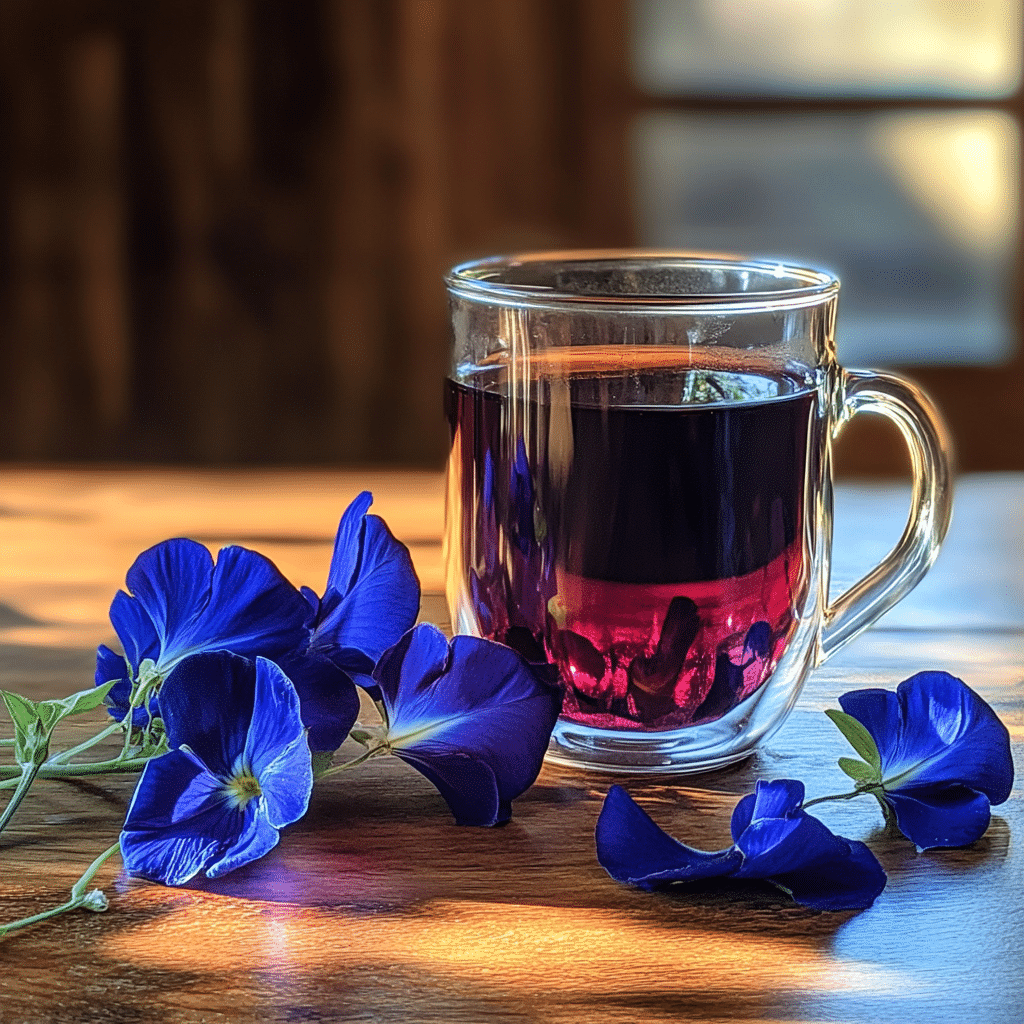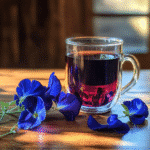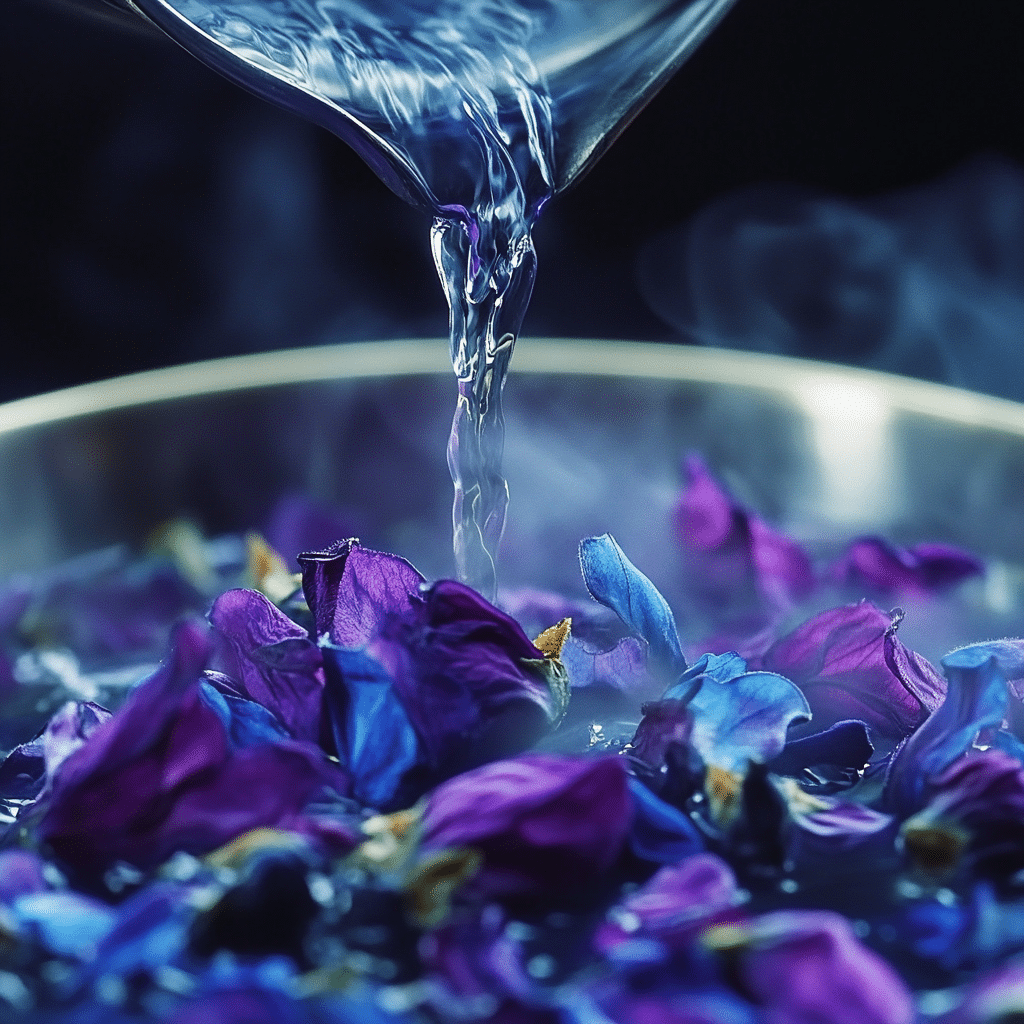Butterfly pea, often known for its electric blue hue and photogenic tea infusions, is much more than just a pretty flower. Native to Southeast Asia, this botanical—scientifically named Clitoria ternatea—has gained global attention for its health-promoting effects, including potential nootropic benefits, antioxidant activity, and even a reputation as a natural aphrodisiac.
In this article, we’ll take a deep dive into everything you need to know about butterfly pea: its traditional uses, scientific benefits, effects on men, possible downsides, and how to make the most of it in your kitchen. We’ll also explore whether drinking it every day is truly safe and what you might experience. Plus, you’ll find answers to some of the most common questions about butterfly pea tea and its effects on your body and mind.
Don’t miss our beginner-friendly herbal drink guide to explore other caffeine-free options alongside butterfly pea!

Table of Contents
Table of Contents
Introduction to Butterfly Pea
What is Butterfly Pea? Origins and Botanical Background
Butterfly pea is a flowering plant from the Fabaceae family, widely found in Thailand, Vietnam, Malaysia, and India. It’s known for its striking indigo-blue petals, which contain powerful antioxidants called anthocyanins. These compounds are responsible for the vibrant color, and they’re also the key players behind many of the flower’s health benefits.
The plant’s scientific name—Clitoria ternatea—comes from the Latin root referencing its distinctive flower shape. While the name might raise an eyebrow, the plant itself has been respected for centuries in herbal medicine traditions like Ayurveda and traditional Chinese medicine.
In its raw or dried form, butterfly pea is used to make herbal teas, natural food colorants, cosmetics, and wellness supplements. It’s caffeine-free, low-calorie, and 100% plant-based, making it an ideal choice for those seeking natural remedies or detox options.
Print
Butterfly Pea: The Vibrant Herbal Powerhouse with Surprising Benefits
- Total Time: 5 minutes
Description
Discover the powerful health benefits of butterfly pea tea—from boosting brain clarity and men’s health to its natural aphrodisiac and antioxidant effects. Learn how to use it daily, explore potential side effects, and try delicious color-changing recipes.
Ingredients
1 tsp dried butterfly pea flowers (or 3–5 petals)
1 cup boiling water
Optional: 1 tsp honey or lemon juice
Instructions
Steep flowers in boiling water for 5–7 minutes.
Add lemon juice for pH-triggered color change.
Serve hot or iced.
- Prep Time: 5 minutes
Historical and Cultural Use of Butterfly Pea in Asia and Ayurveda
In traditional Ayurvedic medicine, butterfly pea is considered a medhya rasayana, which means it’s used to rejuvenate the brain and nervous system. Ancient texts describe it as a herb that enhances memory, reduces stress, and promotes clarity. These effects are consistent with modern studies that highlight the flower’s adaptogenic properties—helping the body resist stressors.
Southeast Asian cultures have used butterfly pea for centuries as a medicinal drink, cosmetic ingredient, and ceremonial offering. In Thailand, for example, butterfly pea tea is commonly served with honey and lime as a cooling herbal remedy. In Malaysian cuisine, the petals are used to dye rice and desserts a deep blue hue—especially in dishes like nasi kerabu.
This enduring cultural relevance, paired with recent scientific interest, has sparked a global wave of enthusiasm. Whether you’re brewing tea or blending smoothies, butterfly pea is now a superfood star that blends ancient wisdom with modern wellness.
Looking for inspiration? Try our color-changing butterfly pea lemonade recipe to wow your guests and taste buds!
Is Butterfly Pea an Aphrodisiac?
Aphrodisiac Effects: Fact or Fiction?
The butterfly pea has sparked curiosity due to its suggestive botanical name and its inclusion in natural libido-enhancing formulas. But does it really function as an aphrodisiac?
In traditional medicine, butterfly pea is sometimes used alongside shatavari or ashwagandha to enhance sexual vitality and reproductive health. While it doesn’t have a direct hormonal effect like maca or tongkat ali, it contributes by enhancing blood circulation and lowering stress—two key pillars of libido.
How Butterfly Pea May Impact Libido and Hormonal Health
Modern science suggests that improved blood flow, antioxidant defense, and reduced oxidative stress can enhance reproductive function in both men and women. While butterfly pea isn’t a testosterone booster, its calming, circulatory-supportive nature may indirectly support sexual health—especially when stress is a contributing factor to low libido.
For men, improved vascular function may support stronger erections. For women, it may reduce cortisol levels and support hormonal balance when combined with other adaptogens.
Learn more about natural aphrodisiac herbs that boost blood flow for better intimacy.
How Does Butterfly Pea Make You Feel?
Psychological and Cognitive Effects of Butterfly Pea Tea
Most users report a sense of mental clarity, reduced anxiety, and calm alertness after drinking butterfly pea tea. Unlike green tea or coffee, it doesn’t stimulate the nervous system but instead works through its mild adaptogenic and anti-inflammatory effects.
People describe it as a drink that supports focus without overstimulation. The tea is naturally caffeine-free, so it’s perfect for those with caffeine sensitivity or anxiety.
Physical Sensations: Calmness, Clarity, and More
Butterfly pea tea is known for its cooling energy in Ayurvedic tradition. It can create a slight tingling sensation in the throat and may promote better digestion, especially when consumed warm after meals.
Its effects are subtle, but consistent daily use could lead to less brain fog, steadier mood, and improved emotional balance over time.
Daily Use – What Happens If You Drink Butterfly Pea Every Day?
Safe Consumption Levels and Ideal Dosage
So, is it safe to enjoy butterfly pea tea daily? Yes, as long as it’s used in moderate amounts. A typical cup made from 3–5 dried flowers or 1 tea bag is considered safe for regular use. Most herbalists recommend no more than 2 cups per day, especially if you’re new to it.
Because it contains natural active compounds, going overboard may lead to digestive upset, especially in sensitive individuals.
Long-term Effects on Metabolism and Immune System
Daily use of butterfly pea tea may support:
- Improved metabolic function
- Better blood sugar control
- Enhanced immune defense due to anti-inflammatory and antimicrobial effects
Long-term benefits may include clearer skin, reduced bloating, and even lower stress-related fatigue. Just remember: herbs are powerful tools, not quick fixes. Consistency is key.
Butterfly Pea Tea and Men’s Health

Male-specific Benefits: Testosterone, Fertility, and Energy
Butterfly pea is gaining popularity among men not only for its antioxidant content but also because of its fertility-supportive properties. It has been traditionally used to support sperm quality, vitality, and reproductive longevity.
Animal studies have shown promising results related to sperm motility and protection against oxidative DNA damage, although more human-based studies are needed to confirm this.
While butterfly pea doesn’t directly increase testosterone, it may protect male reproductive cells from free radical stress, indirectly supporting hormonal balance.
Workout Recovery, Muscle Inflammation, and Mental Clarity
For active men, the anti-inflammatory and antioxidant effects may help reduce post-exercise inflammation. Consuming a cup after workouts can support muscle repair, mental focus, and even help lower cortisol—beneficial for maintaining muscle mass and energy.
Add it to your pre- or post-workout stack for a plant-powered performance boost.
Check out our plant-based performance tea guide for men to enhance energy and clarity naturally.
Potential Side Effects of Butterfly Pea
Who Should Avoid It? Allergies, Medication Interactions
Although butterfly pea is generally considered safe, not everyone should drink it without caution. Some individuals may be allergic to legumes or flowers from the Fabaceae family. In rare cases, sensitive users have reported itchiness, bloating, or a mild rash after consumption.
If you’re on blood pressure medications, diuretics, or anticoagulants, butterfly pea’s vasorelaxant and anti-clotting properties could interact with your regimen. Always consult with a healthcare provider before including it in your daily routine—especially if you’re managing a chronic illness or on prescription meds.
Pregnant or breastfeeding women should avoid large doses, as the flower’s hormonal effects haven’t been widely studied.
Digestive Issues, Nausea, or Other Reported Disadvantages
The most commonly reported side effect is mild stomach discomfort, especially if consumed on an empty stomach or in high quantities. In some cases, it may cause:
- Nausea
- Diarrhea
- Heartburn or reflux
These symptoms usually arise from overuse or combining the tea with other strong herbs. Stick to no more than 2 cups per day, especially if you’re just getting started.
Check out our herbal safety checklist to avoid risky herbal interactions.
Culinary Uses and Recipes with Butterfly Pea
Cooking with Butterfly Pea: Rice, Smoothies, and Mocktails
Butterfly pea is not just a tea—it’s a natural colorant and functional ingredient in many recipes. Its vibrant color makes it perfect for:
- Blue rice (as used in Malaysian nasi kerabu)
- Smoothie bowls
- Natural blue cocktails and mocktails
- Homemade sorbets and popsicles
Pro tip: The tea turns purple or pink when mixed with acidic ingredients like lemon juice, making it ideal for color-changing recipes.
How to Brew the Perfect Butterfly Pea Tea (Cold and Hot Versions)
Hot Tea Instructions
- 1 tsp dried butterfly pea flowers (or 3–5 flowers)
- 1 cup boiling water
- Steep 5–7 minutes
- Optional: add honey and lemon for flavor and color change
Iced Tea Version
- Brew as above, then cool completely
- Pour over ice
- Add mint or lime for extra zing
You can also blend butterfly pea with lemongrass, ginger, or hibiscus for a more flavorful infusion.
FAQ Section
Is butterfly pea an aphrodisiac?
Not directly, but it may help increase blood flow and reduce stress—two factors that support libido naturally. In traditional medicine, it’s used in blends to enhance reproductive health.
How does butterfly pea make you feel?
Butterfly pea may promote a sense of calm, mental clarity, and focus. It doesn’t contain caffeine but supports brain function through antioxidants and adaptogenic properties.
What happens if I drink butterfly pea tea every day?
Daily consumption can offer antioxidant protection, better digestion, and reduced inflammation. Just avoid overuse—stick to 1–2 cups daily.
Is butterfly pea tea good for men?
Yes. It may help protect sperm quality, reduce post-workout inflammation, and support energy levels and mental performance.
Conclusion
Butterfly pea is more than just a trendy tea—it’s a botanical powerhouse rooted in traditional healing and backed by modern science. From enhancing heart health and digestion to offering cognitive support and a stunning visual experience, this flower deserves a place in your kitchen.
Just like any natural remedy, balance is key. Drink it in moderation, combine it with a clean diet, and always consult your healthcare provider if you’re on medication. Whether you’re sipping for relaxation or whipping up a colorful mocktail, butterfly pea is a beautiful way to support your well-being.
Looking for more vibrant, health-boosting tea options?
Don’t miss our complete guide to caffeine-free functional teas with unique blends for every need.
